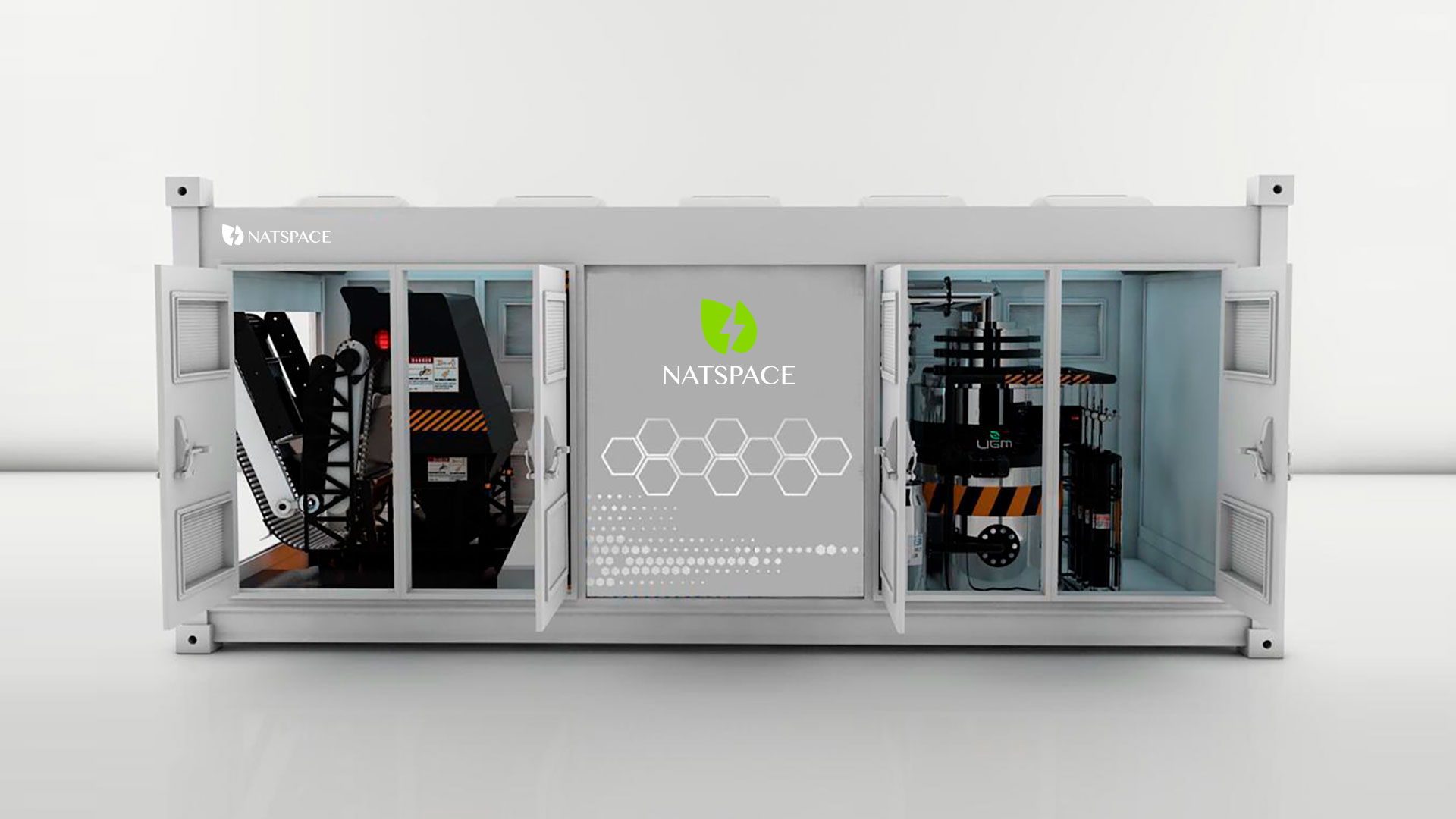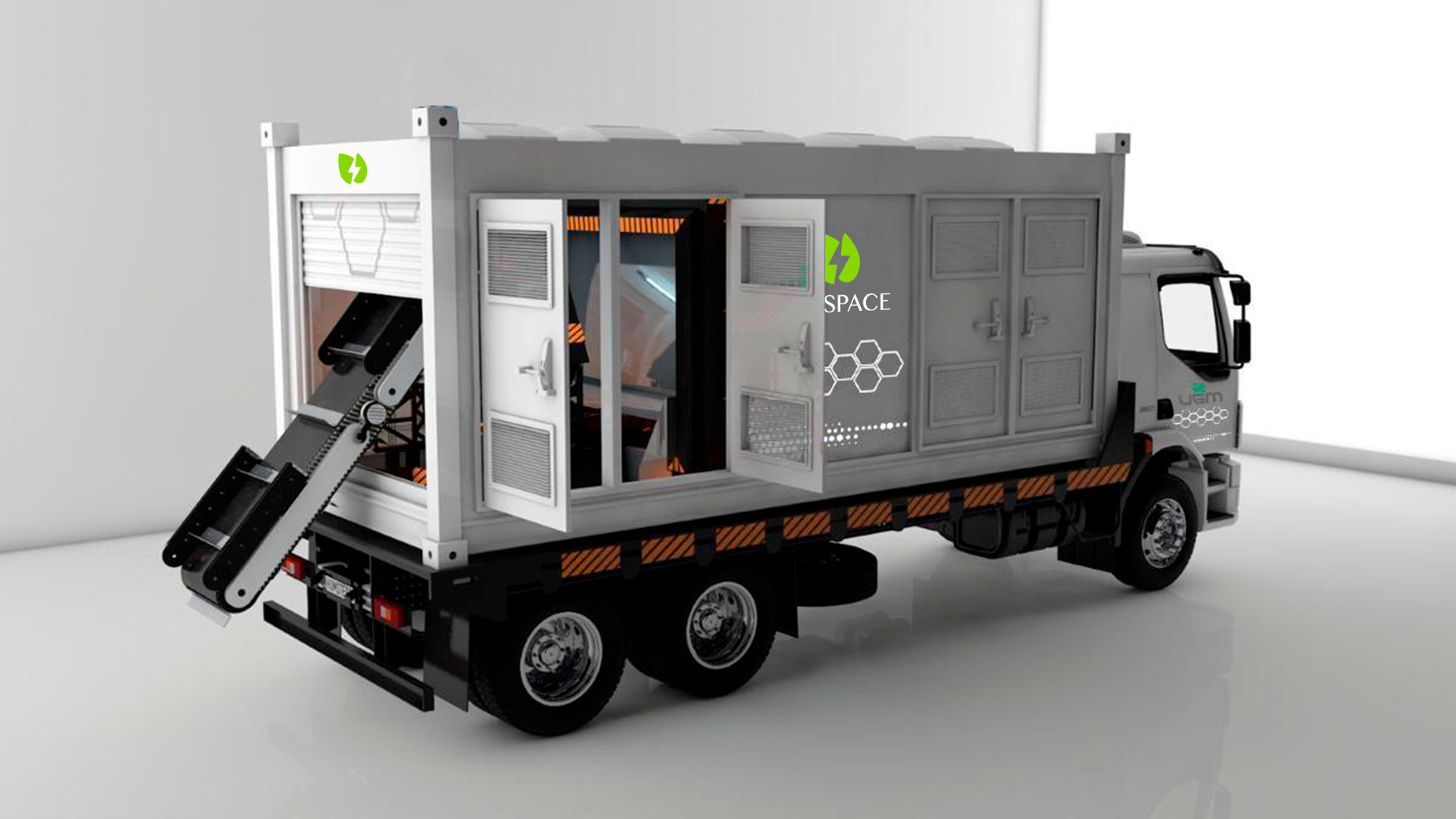

This plant is a versatile Solid Waste Processor which, through the THERMOCHEMICAL GASIFICATION PROCESS, decomposes natural or synthetic organic matter at controlled temperatures of 800 degrees Celsius in an ANAEROBIC FURNACE (absent of oxygen) that does not generate toxic gases or emit pollutants due to its total process. isolation from the outside.
Unlike the NATCN50 Plant, this technology is concentrated in a mobile container which enables its transportation.
The Gasification Process in our equipment begins at a certain minimum temperature, and that is when the waste begins to release gases from its components.
The NATBR series operates at an average temperature of 800 degrees Celsius, a temperature sufficient for the residues inside the furnace to transform into fuel gas, ashes, metals and glass.
The gasification process is a thermochemical reaction in which a material begins to produce gas after reaching a certain temperature, giving rise to this transformation.
The thermochemical reaction results in: hydrogen, methane, carbon monoxide and a small portion of aromatics; the process does not generate liquid or solid pollutants, the residual gases are free of odors, smoke and are duly treated to comply with the emission standards accepted by current legislation.
The NATBR series has 3 panels to control all its auxiliary equipment, motors, burners, electric valves, etc. One of the panels is exclusively for the control of the burners, the other is a touch screen, which will be operated by the responsible technician, the third panel has the general electrical controls.
The pollution reduction compared to a sanitary landfill is approximately 97%, optimizing the use of clean fuels and energies, effectively reducing the environmental impact.

The NATBR series offers state-of-the-art equipment, with automated mechanisms with the purpose of reducing human errors and facilitating its operation and performance.
In the event of an abnormal sharpening effort, caused by excess material in the box or by material with excessive hardness, the control panel retracts the blades (automatic reversal system), the rest of the equipment that is part of it also They have a security system. This system increases the safety of the equipment and prevents component breakage.
The gas filter consists of a tank with an approximate volume of 0.5 m3, made of stainless steel, filled with an activated carbon fiber blanket. The gases are directed to the filter where the aromatics that are absorbed by the filter material are retained, based on the tests carried out, and then the gas is separated, which will be used as fuel and the rest, before being discarded, passes through a catalyst.
Technical Standards and Tests
The equipment we distribute is thoroughly tested to ensure its quality and safety.
Before leaving the factory, the equipment undergoes welding tests, penetrant / developer tests, operation tests, equipment sizing inspection, among others. All tests are overseen by a mechanical engineer who certifies the equipment and NR-12 compliance.
The regulatory provisions contained in ISO 9001 and 14001, OHASA 18001 and the recommendations contained in the NBR are applied.



The Mobile Gas Plant is machinery with state-of-the-art technology that allows the treatment of urban solid waste, to convert it into Synthetic Gas (syngas). It has a maximum treatment capacity of 20 tons of urban solid waste per day distributed in 3 shifts of 6 hours.
The equipment is designed in order to have complete "thermal and acoustic" insulation between the outside and the inside.
The oven has a total isolation system, so that it can be operated without the use of personal protective equipment.
1. Residue recolection.
2. They are crushed and fed to an anaerobic furnace (without the presence of oxygen) and the material is incinerated with a gas-fuel composed of CH4 (34% methane), CO (carbon monoxide 43%) and H2 (23% hydrogen). ), the process occurs between 800 °C and 1000 °C.
3. The residues produced are ashes, metals and glass products in a proportion of 3% of the material introduced in the furnace.
4. Then the process of cooling the gas produced is carried out.
5. Gas flushing and condensation of existing moisture is performed.
6. The next phase is compression for storage. The clean gas-fuel must be used as fuel for the furnace, the generator produces the energy required for the various equipment installed in the unit.
Bucket for lifting the collected material with a capacity of 0.5 m3.
Receiving hopper with a capacity of 0.5 m3.
Shredder with a capacity of 1.5 m3 per hour.
Pre-Oven storage hopper with 0.3 m3 capacity.
Conveyor system with a capacity of 1.5 m3 per hour.
Capacity to process 1.5 m3 of Urban Solid Waste per hour.
Two burners for waste processing consisting of auxiliary equipment.
Produced gas washing system and tank with a capacity of 1.5 m3.
Produced gas storage system with: compressor and booster
Generator with the capacity to operate the various electrical equipment.
Waste storage and disposal system.
General control panels of the equipment and remote control.
Safety valves to prevent possible accidents.
Our plants generate gas for: operation, sale or fuel to generate electricity, offering a direct improvement to the environment and health due to its anaerobic oxygen-free incinerator, which, unlike other solutions, offers the following benefits: SELF-SUSTAINABILITY, SAVINGS and HIGH PRODUCTIVITY.
1. It generates gas for its operation and sale or fuel to generate electricity.
2. Improves the Government Image by taking initiative in a global problem.
3. Direct improvement in the environment and health due to its anaerobic oxygen-free incinerator. It does not release polluting emissions, it does not contaminate aquifers, it does not emit gases that damage the ozone layer and it does not contribute to carcinogenic diseases like the traditional sanitary landfill.
1. Land extensions.
2. Staff.
3. Operating expenses.
4. Installations.
5. Exponential increase in confinement capacity.
6. Reduce garbage to 3% (30 kg of ash, glass and metal per ton of garbage).
1. Stationary operation.
2. Processes 20 tons of garbage in 24 hours in 6-hour shifts with two hours of rest between intervals.
3. Gas: 14,400 m3 per Unit.
4. Power - megawatts (Container): 1.0 megawatts per hour.
5. Diesel: Zero fuel cost. The consumption of the "Container" is fed by the GAS generated.
6. Lubricants and washing: 40% reduction in spending on consumables.
7. Mortal ashes: 270 Kg per Turn.